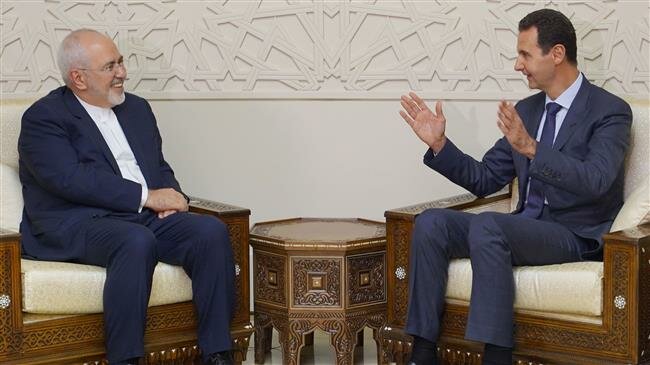Iran’s investments in Syria in jeopardy thanks to US sanctions

Sanctions leveled by the US on the Iranian government’s military institution — the Islamic Revolutionary Guard Corps (IRGC) and its affiliates — as well as the banking system and the oil sector are placing significant pressure on the Islamic Republic.
Iran’s economy shrank last year and is expected to decrease by 3.6 percent or more this year, according to a recent report published by the International Monetary Fund. Iran’s oil exports have also declinedby more than half, and its national currency, the rial, continues to lose its value, while the flood disaster is adding further weight to the economic crisis.
But it is not only inside the country that the Iranian leaders are feeling the economic losses; Tehran’s economic influence, investments and assistance to other countries, particularly Syria, are being negatively impacted too.
In addition to military and geopolitical assistance, economic interference was one of the most important tools that the Iranian regime utilized to intervene in Syria, make profits, control the Arab state, and help keep President Bashar Assad in power.
While the two countries played almost equal roles in bilateral economic trade, business dealings and investments before the conflict in Syria erupted, Tehran has since provided considerable amounts of financial assistance and made significant investments across the country. This granted Iran economic leverage over Damascus and caused its debt and dependence on Iran to increase dramatically.
For example, a few months after the conflict began, the Iranian authorities signeda $10 billion agreement with Syria and Iraq for the construction of a natural gas pipeline that would start in Iran, run through Syria, Lebanon and the Mediterranean, and reach several Western countries.
Tehran also opened a credit line for Syria and investeda considerable amount of resources, skilled forces and labor in Damascus. Iranian Supreme Leader Ali Khamenei supportedthe allocation of billions of dollars in aid to Syria, including $5.8 billion that was provided by Iran’s Center for Strategic Research, which concentrates on Tehran’s strategies in six areas, including foreign policy research, Middle East and Gulf research, and international political economy research.
Tehran also began establishing military bases across Syria, while Iranian authorities and Assad made plans for more comprehensive agreements that sought to establish a regional economic bloc. This included a 17-article agreementthat was signed by both parties and focused on “trade, investment, planning and statistics, industries, air, naval and rail transportation, communication and information technology, health, agriculture, (and) tourism.”
While the two countries played almost equal roles in bilateral economic trade, business dealings and investments before the conflict in Syria erupted, Tehran has since provided considerable amounts of financial assistance and made significant investments across the country.
Dr. Majid Rafizadeh
Iran’s investments in Syrian infrastructure, power generation capabilities and its gas market also increased as part of the reconstruction process.
But Iran cannot afford to maintain its business dealings in Syria. One day after Foreign Minister Mohammed Javad Zarif visited Syria on April 16, Syrian newspaper Al-Watan revealed, in an unprecedented move, that Tehran had halted its credit line to Damascus.
Tehran has also been incapable of shippingoil to Syria in the last six months. Accordingto Al-Watan, this has caused significant fuel shortages because Syria only produces roughly 25 percent of the fuel that the nation needs.
The fact that a Syrian newspaper made such disclosures just after Zarif’s visit indicates that Damascus most likely failed to convince Tehran to extend its credit line and oil exports.
The US sanctions on currency transactions have also impacted Iran’s dealings with Syria because the Iranian-Syrian economic alliance has operated using multi-level contracts involving state and semi-private organizations through the adoption of the dollar for transactions.
One of the major reasons that the Iranian government was previously capable of offering billions of dollars of credit, free oil exports and investments in Syria was due to the nuclear deal, which lifted four rounds of UN sanctions against Tehran and increased the regime’s revenues remarkably.
Another area that has been impacted is the military cooperation between the two nations thanks to the recent designation of the IRGC as a terrorist group by the US. Arms trade with Damascus is critical for Khamenei and the senior cadre of the IRGC to strengthen Syria’s defense systems because the survival of the Assad regime is considered a matter of national security for Iran.
In a nutshell, US sanctions are putting significant pressure on Iran domestically and regionally. Tehran has invested billions of dollars in Syria, but its investments are currently at risk as the regime cannot afford to spend such amounts assisting Assad. To the Syrian president’s dismay, Iran cannot act as Syria’s economic lifeline any longer.
- Dr. Majid Rafizadeh is a Harvard-educated Iranian-American political scientist. He is a leading expert on Iran and US foreign policy, a businessman and president of the International American Council. Twitter: @Dr_Rafizadeh








































